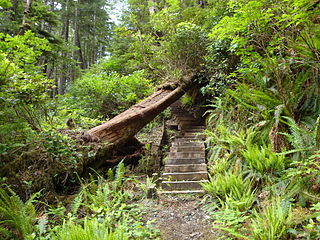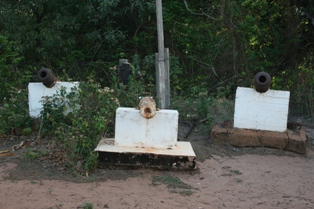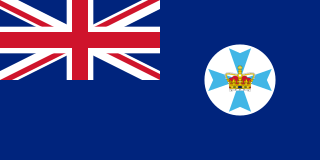
Cape York Peninsula is a peninsula located in Far North Queensland, Australia. It is the largest wilderness in northern Australia. The land is mostly flat and about half of the area is used for grazing cattle. The relatively undisturbed eucalyptus-wooded savannahs, tropical rainforests and other types of habitat are now recognised and preserved for their global environmental significance. Although much of the peninsula remains pristine, with a diverse repertoire of endemic flora and fauna, some of its wildlife may be threatened by industry and overgrazing as well as introduced species and weeds.

Moreton Island (Mulgumpin) is an island on the eastern side of Moreton Bay on the coast of South East Queensland, Australia. The Coral Sea lies on the east coast of the island. Moreton Island lies 58 kilometres (36 mi) northeast of the Queensland capital, Brisbane. 98% of the island is contained within a national park and a popular destination for day trippers, four wheel driving, camping, recreational angling and whale watching and a 75-minute ferry ride from Brisbane. It is the third largest sand island in the world. Together with Fraser Island, Moreton Island forms the largest sand structure in the world. It was the traditional country of the Ngugi before settlement.

Thursday Island, colloquially known as TI, or in the Kawrareg dialect, Waiben or Waibene, is an island of the Torres Strait Islands, an archipelago of at least 274 small islands in the Torres Strait. TI is located approximately 39 kilometres north of Cape York Peninsula in Far North Queensland, Australia.

Cape Moreton is a rocky headland at the north eastern tip of Moreton Island in South East Queensland, Australia. The surrounding area is part of the Moreton Island National Park. Flinders Reef is 5 kilometres (3 mi) north-west of Cape Moreton.

The Australian Overland Telegraph Line was an electrical telegraph system for sending messages the 3200 kilometres between Darwin, in what is now the Northern Territory of Australia, and Adelaide, the capital of South Australia. Completed in 1872, it allowed fast communication between Australia and the rest of the world. When it was linked to the Java-to-Darwin submarine telegraph cable several months later, the communication time with Europe dropped from months to hours; Australia was no longer so isolated from the rest of the world. The line was one of the great engineering feats of 19th-century Australia and probably the most significant milestone in the history of telegraphy in Australia.

Cape Scott Provincial Park extends from Shushartie in the east, then westward around Cape Scott and south to San Josef Bay. This coastline comprises the northern tip of Vancouver Island, British Columbia. The 22,294-hectare (55,090-acre) provincial park is about 563 km (350 mi) northwest of Victoria.

Holberg is a former ferry terminal about 35 kilometres (22 mi) from the northwest tip of Vancouver Island, British Columbia. This unincorporated community is at the head of Holberg Inlet, which forms the western arm of Quatsino Sound.

Somerset is a coastal locality split between the Shire of Torres and the Northern Peninsula Area Region, Queensland, Australia. In the 2021 census, Somerset had "no people or a very low population".

Mount Adolphus Island, also called Muri or Mori in the native language, is an island of the Torres Strait Islands archipelago that is located at the very tip of Cape York Peninsula on the northern side of the Adolphus Channel, across from Albany Island and about 40 kilometres (25 mi) northeast of Bamaga in the far north region of Queensland, Australia.

The Prince of Wales Island, or Muralag, is an island of the Torres Strait Islands archipelago at the tip of Cape York Peninsula within the Endeavour Strait of Torres Strait in Queensland, Australia. The island is situated approximately 20 km (12 mi) north of Muttee Heads which is adjacent to Bamaga and south of Thursday Island. It is within the locality of Prince Of Wales within the Shire of Torres. In the 2021 census, Prince Of Wales had a population of 62 people.

Francis Lascelles (Frank) Jardine was a Scottish-Australian pioneer who was at the forefront of British colonisation and Aboriginal dispossession in the Cape York Peninsula and Torres Strait regions of Far North Queensland.

Macleay Island is an island in Moreton Bay, South East Queensland, Australia. The island constitutes a town and locality within the City of Redland. In the 2021 census, Macleay Island had a population of 3,193 people.

RMS Quetta was an iron-hulled steamship that was built in Scotland in 1881 and wrecked with great loss of life in the Torres Strait in 1890. She was operated by British India Associated Steamers (BIAS), which was controlled by the British India Steam Navigation Company (BISN). She was wrecked on a previously unknown rock, which has been called Quetta Rock ever since. The Underwater Cultural Heritage Act 2018 protects the wreck.

Australia was a relatively early adopter of electrical telegraph technology in the middle of the nineteenth century, despite its low population densities and the difficult conditions sometimes encountered in laying lines. From 1858 onwards, the major capitals were progressively linked, culminating in the addition of Perth in 1877. Australia was linked to the rest of the world for the first time in 1872, through the Overland Telegraph which ran some 3,200 kilometres (2,000 mi) from Adelaide through to Darwin. The network continued to expand in size and sophistication until 1959 and in heavy usage until 1945, after which time telephone usage began to erode public patronage of telegraphy services. The final publicly provided telegraphy service was closed in 1993.

Ferguslie Peninsula is a peninsula 2.4 km (1.5 mi) long, lying between Browns Bay and Macdougal Bay on the north coast of Laurie Island, in the South Orkney Islands of Antarctica. The peninsula was charted in 1903 by the Scottish National Antarctic Expedition under William Speirs Bruce, who named it for Ferguslie, the residence of James Coats, chief patron of the expedition.

The Colony of Queensland was a colony of the British Empire from 1859 to 1901, when it became a State in the federal Commonwealth of Australia on 1 January 1901. At its greatest extent, the colony included the present-day State of Queensland, the Territory of Papua and the Coral Sea Islands Territory.

Musgrave Telegraph Station is a heritage-listed former telegraph station and now roadhouse at Peninsula Developmental Road, Musgrave, Yarraden, Shire of Cook, Queensland, Australia. It is also known as Musgrave Roadhouse. It was added to the Queensland Heritage Register on 21 August 1992.
The Cape York Telegraph Line was a telegraph line built on the Cape York Peninsula, Queensland, Australia. It was completed in 1887 and stretched from Laura to Thursday Island.
The Lotiga, also known as the Okara, were an indigenous Australian people of the Cape York Peninsula of North Queensland.

Somerset Graves Site is a heritage-listed cemetery at Somerset, Northern Peninsula Area Region, Queensland, Australia. It is also known as Somerset Jardine Cemetery. It was added to the Queensland Heritage Register on 25 January 2018.





















